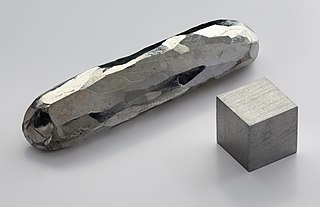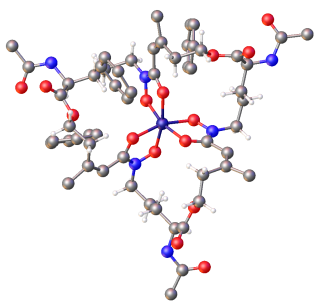Related Research Articles

Cadmium is a chemical element; it has symbol Cd and atomic number 48. This soft, silvery-white metal is chemically similar to the two other stable metals in group 12, zinc and mercury. Like zinc, it demonstrates oxidation state +2 in most of its compounds, and like mercury, it has a lower melting point than the transition metals in groups 3 through 11. Cadmium and its congeners in group 12 are often not considered transition metals, in that they do not have partly filled d or f electron shells in the elemental or common oxidation states. The average concentration of cadmium in Earth's crust is between 0.1 and 0.5 parts per million (ppm). It was discovered in 1817 simultaneously by Stromeyer and Hermann, both in Germany, as an impurity in zinc carbonate.

A toxic heavy metal is any relatively dense metal or metalloid that is noted for its potential toxicity, especially in environmental contexts. The term has particular application to cadmium, mercury and lead, all of which appear in the World Health Organization's list of 10 chemicals of major public concern. Other examples include manganese, chromium, cobalt, nickel, copper, zinc, silver, antimony and thallium.

Iron (Fe) deficiency is a plant disorder also known as "lime-induced chlorosis". It can be confused with manganese deficiency. Soil iron concentration is high, but can become unavailable for absorption if soil pH is higher than 6.5. Excess of elements such as manganese in the soil can interfere with plant iron uptake triggering iron deficiency.

Siderophores (Greek: "iron carrier") are small, high-affinity iron-chelating compounds that are secreted by microorganisms such as bacteria and fungi. They help the organism accumulate iron. Although a widening range of siderophore functions is now being appreciated, siderophores are among the strongest (highest affinity) Fe3+ binding agents known. Phytosiderophores are siderophores produced by plants.

Phytoremediation technologies use living plants to clean up soil, air and water contaminated with hazardous contaminants. It is defined as "the use of green plants and the associated microorganisms, along with proper soil amendments and agronomic techniques to either contain, remove or render toxic environmental contaminants harmless". The term is an amalgam of the Greek phyto (plant) and Latin remedium. Although attractive for its cost, phytoremediation has not been demonstrated to redress any significant environmental challenge to the extent that contaminated space has been reclaimed.
Bioinorganic chemistry is a field that examines the role of metals in biology. Bioinorganic chemistry includes the study of both natural phenomena such as the behavior of metalloproteins as well as artificially introduced metals, including those that are non-essential, in medicine and toxicology. Many biological processes such as respiration depend upon molecules that fall within the realm of inorganic chemistry. The discipline also includes the study of inorganic models or mimics that imitate the behaviour of metalloproteins.

Salix viminalis, the basket willow, common osier or osier, is a species of willow native to Europe, Western Asia, and the Himalayas.

A hyperaccumulator is a plant capable of growing in soil or water with high concentrations of metals, absorbing these metals through their roots, and concentrating extremely high levels of metals in their tissues. The metals are concentrated at levels that are toxic to closely related species not adapted to growing on the metalliferous soils. Compared to non-hyperaccumulating species, hyperaccumulator roots extract the metal from the soil at a higher rate, transfer it more quickly to their shoots, and store large amounts in leaves and roots. The ability to hyperaccumulate toxic metals compared to related species has been shown to be due to differential gene expression and regulation of the same genes in both plants.

Sulfur assimilation is the process by which living organisms incorporate sulfur into their biological molecules. In plants, sulfate is absorbed by the roots and then be transported to the chloroplasts by the transipration stream where the sulfur are reduced to sulfide with the help of a series of enzymatic reactions. Furthermore, the reduced sulfur is incorporated into cysteine, an amino acid that is a precursor to many other sulfur-containing compounds. In animals, sulfur assimilation occurs primarily through the diet, as animals cannot produce sulfur-containing compounds directly. Sulfur is incorporated into amino acids such as cysteine and methionine, which are used to build proteins and other important molecules.
This list covers known nickel hyperaccumulators, accumulators or plant species tolerant to nickel.
This list covers hyperaccumulators, plant species which accumulate, or are tolerant of radionuclides, hydrocarbons and organic solvents, and inorganic solvents.

Rhizofiltration is a form of phytoremediation that involves filtering contaminated groundwater, surface water and wastewater through a mass of roots to remove toxic substances or excess nutrients.

Salsola tragus, often known by its synonym Kali tragus is a species of flowering plant in the family Amaranthaceae. It is known by various common names such as prickly Russian thistle, windwitch, or common saltwort. It is widely known simply as tumbleweed because, in many regions of the United States, it is the most common and most conspicuous plant species that produces tumbleweeds. Informally, it may be known as "'Kali or Salsola": the latter being its restored genus, containing 54 other species, into which the obsolete genus Kali has been subsumed.

Environmental effects of mining can occur at local, regional, and global scales through direct and indirect mining practices. Mining can cause erosion, sinkholes, loss of biodiversity, or the contamination of soil, groundwater, and surface water by chemicals emitted from mining processes. These processes also affect the atmosphere through carbon emissions which contributes to climate change.
Phytotechnology implements solutions to scientific and engineering problems in the form of plants. It is distinct from ecotechnology and biotechnology as these fields encompass the use and study of ecosystems and living beings, respectively. Current study of this field has mostly been directed into contaminate removal (phytoremediation), storage (phytosequestration) and accumulation. Plant-based technologies have become alternatives to traditional cleanup procedures because of their low capital costs, high success rates, low maintenance requirements, end-use value, and aesthetic nature.
Athyrium yokoscense, commonly known as Asian common ladyfern in English and as Hebino-negoza in Japanese, is a species of fern in the family Athyriaceae. These tough plants live primarily in and around mine sites and thrive in soils contaminated with high concentrations of heavy metals, such as zinc, cadmium, lead, and copper. A. yokoscense is indigenous to Japan, Korea, eastern Siberia and northeastern China and has been known for centuries to tolerate phytotoxic mining sites. The predominance and concentration of this fern species at a particular region was used to identify potential mining sites. The primary potential of A. yokoscense is in its phytoremediative ability to accumulate toxic metals from soils contaminated with heavy metals, so it may have some long-term commercial importance. No medicinal or culinary values of this fern species have been studied or confirmed.

Pycnandra acuminata is a species of plant in the family of Sapotaceae. It is a rainforest shrub, endemic to New Caledonia, and is adapted to the nickel-rich ultramafic soils found there. Pycnandra acuminata is notable as one of the most prolific hyperaccumulators of trace metals known, actively absorbing nickel from the soil and concentrating it within the plant to a concentration of up to 25% nickel citrate as dry weight of the sap, which is turquoise-green in colour due to the nickel content. It is the only known plant with turquoise sap. An excellent photo can be seen at. The vernacular name in French is sève bleue.

Alyssum serpyllifolium, the thyme-leaved alison, is a species of flowering plant in the family Brassicaceae, native to the western Mediterranean region. It is adapted to serpentine soils. The Royal Horticultural Society recommends it for rock gardens.
In Environmental epigenetics, Exposure to certain materials or chemicals can cause an epigenetic reaction. The epigenetic causing substances cause issues like altered DNA methylation, CpG islands, chromatin, along with other transcription factors. Environmental epigenetics aims to relate such environmental triggers or substances to phenotypic variation. Numerrous studies have demonstrated how exposure to environmental pollutants, such as heavy metals, pesticides, and air pollutants, can induce epigenetic changes in various organisms. For example, research has shown that exposure to pollutants like biphenol A (BPA) and polycyclic acromatic hydrocarbons (PAHs) can lead to DNA methylation changes and histone modifications in plants, animals, and humans.
References
- ↑ "The MSDS HyperGlossary: Heavy Metal". www.ilpi.com. Archived from the original on 2011-09-23. Retrieved 2011-10-30.
- ↑ Guidi Nissim W., Palm E., Mancuso S., Azzarello E. (2018) “Trace element phytoextraction from contaminated soil: a case study under Mediterranean climate”. Environmental Science and Pollution Research https://doi.org/10.1007/s11356-018-1197-x Archived 2021-10-06 at the Wayback Machine
- ↑ Misra V., Tiwari A., Shukla B. & Seth C.S. (2009) Effects of soil amendments on the bioavailability of heavy metals from zinc mine tailings. Environmental Monitoring Assessment 155, 467–475.
- ↑ Han F., Shan X.Q., Zhang S.Z., Wen B. & Owens G. (2006) Enhanced cadmium accumulation in maize roots – the impact of organic acids. Plant and Soil 289, 355–368.
- ↑ Clemens S., Palmgren M.G. & Krämer U. (2002) A long way ahead: understanding and engineering plant metal accumulation. Trends in Plant Science 7, 309–315.
- ↑ Seth, C. S., et al. "Phytoextraction of Toxic Metals: A Central Role for Glutathione." Plant, Cell and Environment (2011)SCOPUS. Web. 16 October 2011.
- 1 2 Rascio, N., and F. Navari-Izzo. "Heavy Metal Hyper-accumulating Plants: How and Why do they do it? and what Makes them so Interesting?" Plant Science 180.2 (2011): 169-81. SCOPUS. Web. 16 October 2011.
- ↑ Küpper, Hendrik; Leitenmaier, Barbara (2013). "Chapter 12. Cadmium-accumulating plants". In Astrid Sigel, Helmut Sigel and Roland K. O. Sigel (ed.). Cadmium: From Toxicology to Essentiality. Metal Ions in Life Sciences. Vol. 11. Springer. pp. 373–413. doi:10.1007/978-94-007-5179-8_12. ISBN 978-94-007-5178-1. PMID 23430779.
- ↑ K.B. Axelsen and M.G. Palmgren, Inventory of the superfamily of P-Type ion pumps in Arabidopsis. Plant Physiol., 126 (1998), pp. 696–706.
- ↑ A. Papoyan and L.V. Kochian, Identification of Thlaspi caerulescens genes that may be involved in heavy metal hyper-accumulation and tolerance. Characterization of a novel heavy metal transporting ATPase. Plant Physiol., 136 (2004), pp. 3814–3823.
- ↑ M. Hanikenne, et al. Evolution of metal hyper-accumulation required cis-regulatory changes and triplication of HMA4. Nature, 453 (2008), pp. 391–395
- ↑ Rascio, N., and F. Navari-Izzo. "Heavy Metal Hyperaccumulating Plants: How and Why do they do it? and what Makes them so Interesting?" Plant Science 180.2 (2011): 169-81. SCOPUS. Web. 16 October 2011.
- ↑ Misbahuddin, M., and A. Fariduddin. "Water Hyacinth Removes Arsenic from Arsenic-Contaminated Drinking Water." Archives of Environmental Health 57.6 (2002): 516-8. SCOPUS. Web. 26 September 2011.